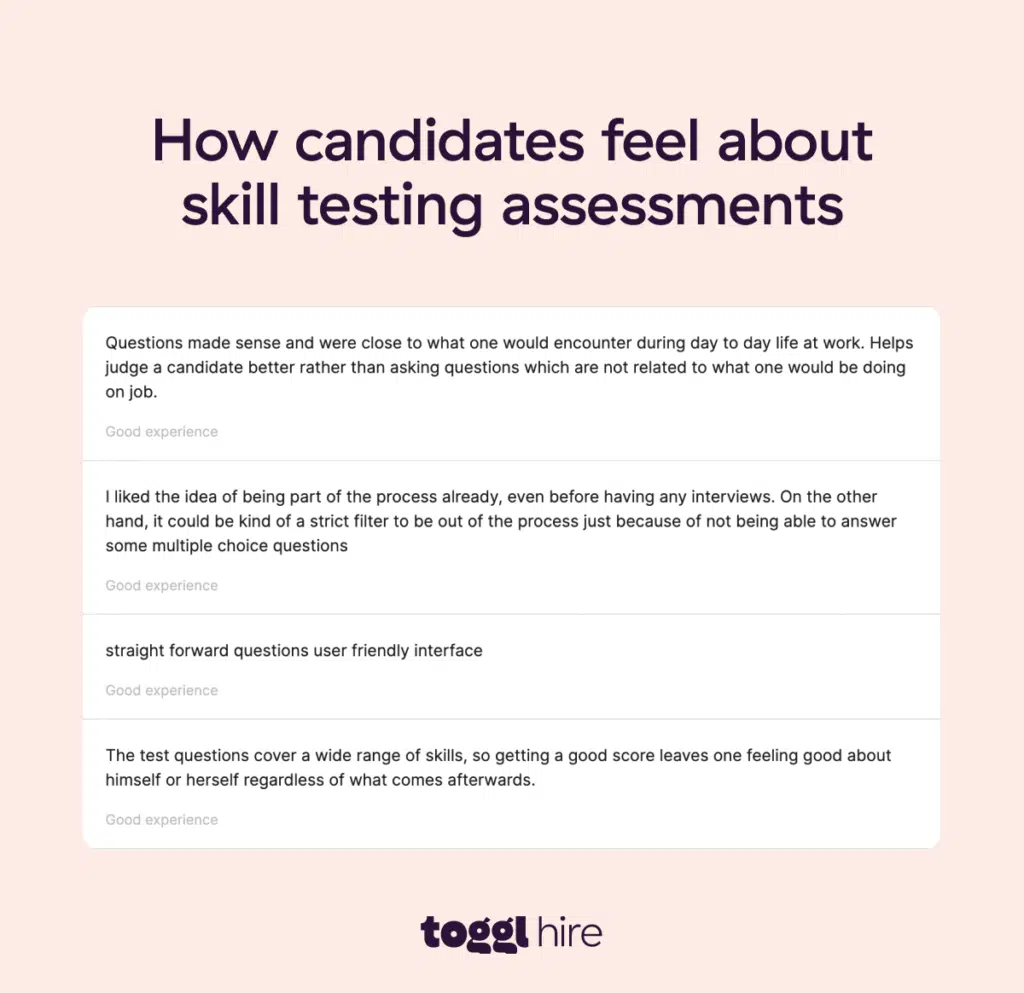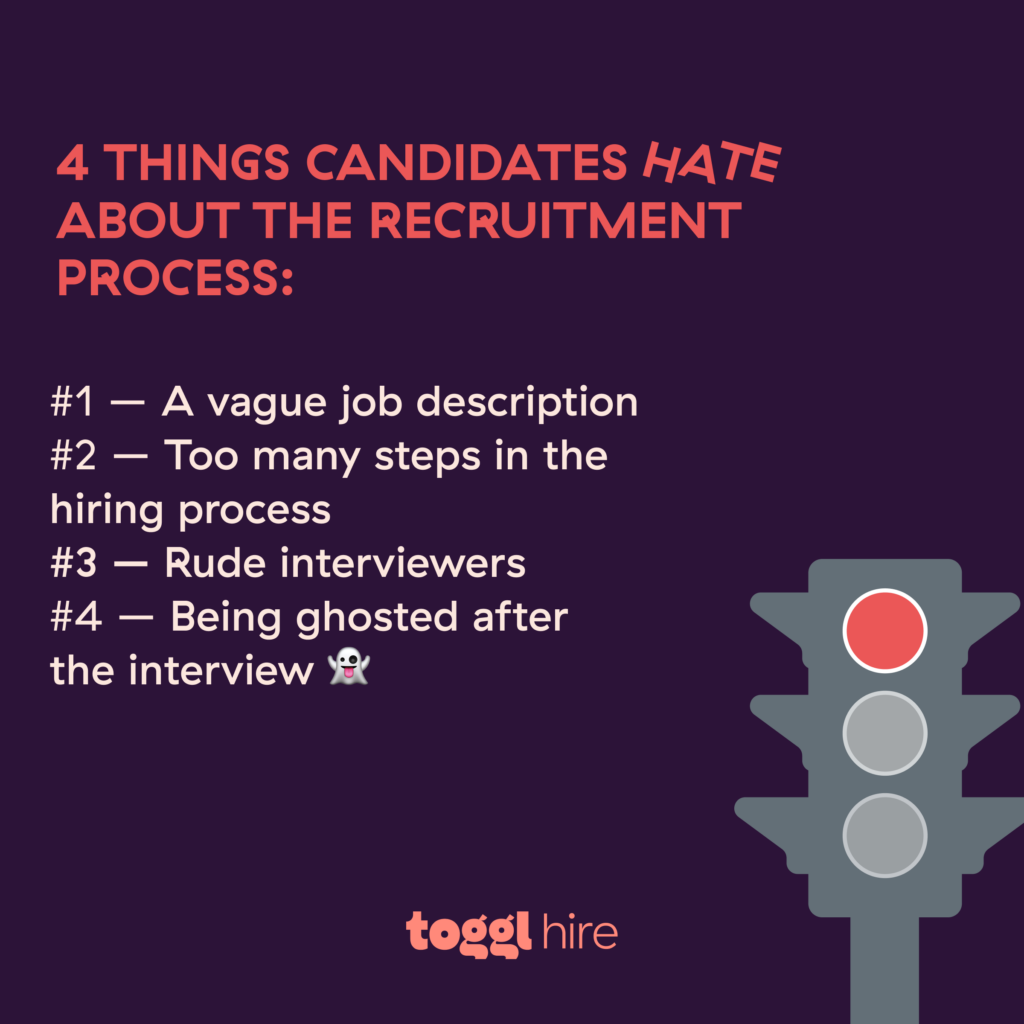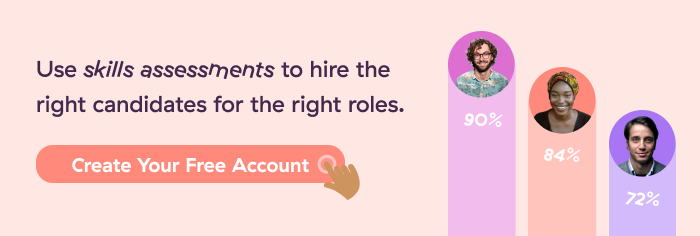In 2023, 49% of job hunters rejected a job offer because of a poor candidate experience. If you don’t want to hemorrhage top talent at those levels, listen up.
Candidate experience might sound like just a buzzword, but it’s a key factor that could make or break everything from your hiring process to your reputation.
If you’re a hiring manager, recruiter, or business leader aiming to attract top talent and boost your employer brand in the process, understanding and enhancing the candidate experience is crucial. Here’s what to know based on industry insights and feedback we’ve received from recent hiring rounds…
TL;DR — Key Takeaways
The candidate experience covers every touchpoint a candidate has with your company from the moment they apply to the offer and onboarding period.
Six key components that can help make or break the candidate experience include the job ad, employer branding, application, selection process, offer, and onboarding.
Candidate experience matters a lot more than most businesses think. It helps you: attract more applications, compete for top talent, save time and money, boost retention, and get better-quality hires.
You can improve your candidate experience by clearly defining what you’re looking for and why, giving timely feedback, respecting your candidates’ time, and leaning on skills test tools for help.
Hiring tools like Toggl Hire can help you improve your candidate experience by offering an unbiased, quick, and easy way to screen candidates and provide them with personalized, timely feedback on their applications.

What is candidate experience?
Candidate experience covers every touchpoint a job seeker encounters throughout all stages of your recruitment cycle, from their impression of the job descriptions you post to their final onboarding experience.
This matters a lot in today’s hiring landscape, as 77% of hiring managers around the world say they’re struggling to find the talent they need. That’s up from 35% just ten years earlier.
Additionally, 54% of candidates have abandoned the hiring process due to poor communication from the hiring manager.
It’s not just about the job search itself, though, in terms of appealing to more job seekers with the right words in a job description or the right interview tactics.
A poor candidate experience can also negatively affect your company’s brand reputation long-term, too. 72% of candidates who had a negative hiring experience wrote about it online. Candidates who have negative experiences are 185% less likely to be willing to refer other job seekers to your company.

Key components of the candidate experience
There are six main touchpoints that affect a candidate’s decision to apply for a role, accept an offer, and ultimately positively review your talent acquisition team’s effectiveness in the process.
To improve the candidate experience, you’ll first need to take a closer look at six key components that make up the experience as a whole. Understanding each of these components allows you to identify where you might be creating a less-than-positive candidate experience for your future new employees.
1. Job ad
The job ad is the first interaction potential candidates have with your company, making it your first opportunity to truly wow and inform them.
Remember, it’s not just about listing responsibilities and requirements — it’s an opportunity to showcase your company’s culture, mission, and values. To improve this aspect of candidate experiences, highlight potential career paths, emphasize your commitment to diversity, and promote perks that set you apart.
Example of a positive candidate experience with a job ad:
You list the necessary expectations of the role, the company values and vision, clearly state what’s in it for prospective candidates, and the salary range, so they’re empowered up front and know what to expect going into the recruiting process.
2. Employer brand
Your employer brand is the perception of your company in the eyes of potential employees, playing a vital role in attracting and retaining top talent. A strong employer brand not only draws in applicants but also helps ensure that those who join feel aligned with your company.
To enhance this aspect of the candidate experience, ensure you’re consistently communicating your company’s values, culture, and vision at every stage of the hiring process.
Example of a good candidate experience with your employer brand:
Your Glassdoor page has a 4.8 rating that gets candidates excited about the prospect of working with you. You’ve got rave reviews, and your past and current employees act as your biggest ambassadors.
3. Application process
It’s 2024, and job seekers know that they don’t have to spend hours applying for a job anymore. Make the application process quick, interesting, and easy so that they can submit the necessary information and move on.
The longer it takes to apply, the fewer chances of getting high-quality candidates.
Example of a good candidate experience during the application process:
Using a skills-testing tool like Toggl Hire can save you up to 22 hours per position by qualifying the most suitable candidates early on in the recruiting process.
4. Selection process
Taking too long with your interview process could mean losing your best candidate to a competing offer.
Of the 70% of candidates who considered dropping out of their last hiring process, the top two most-cited reasons were that the process was taking too long or that it was too complex.
It’s best to limit the screening process, tests, and other types of assessments to only what’s necessary.
Example of a good candidate experience during the selection process:
Quick communication and feedback through different application stages are key to high candidate engagement and an exceptional candidate experience.
5. Offer
Job offers are a crucial, defining moment in the candidate experience. Being transparent about the salary from the start can help set expectations of what’s to come. By the time you extend an offer to the right candidates, they should have no reason not to accept it.
However, it’s not just about being upfront about money. The job offer should also be fair and competitive with other similar roles in your industry.
Example of a good candidate experience when receiving an offer:
You show genuine excitement for your new hires and seamlessly transition them into employees while equally maintaining a dignified and fair process for rejecting unsuccessful applicants.
6. Onboarding
When the transition from the recruitment process to onboarding is smooth and effortless, candidates feel more appreciated and are more likely to stay with the company for the long haul.
Example of a good candidate experience during onboarding:
An automated, optimized onboarding flow guided by the employer will ensure your newest team member has a smooth transition into the company.

Why a positive candidate experience matters
For future candidates looking to join a company, candidate experience is a great reflection of the overall experience of working for that company.
In 2024, high-quality candidates know there’s plenty of opportunity all around. If you’re not treating them with fairness and dignity, they’ll quickly move on to another employer who will.
Attract more applicants
A short and simple hiring process can increase your application and acceptance rates dramatically. It reflects well on your company culture, values, and reputation. It also makes applicants feel valued and respected, increasing their interest in your organization.
Compete for top talent
40% of candidates reject a job offer because they’ve already accepted another one. Making your hiring process faster, better, and easier can help you win over the best job seekers before your competitors do by leaving an amazing first impression.
Improve quality of hire
According to American International Group, when employers engage in consistent communication, they end up with better new talent. Indeed, 65% of candidates say they never hear back from job applications. Give the people what you want, and you’ll reap the rewards.
Reduce hiring costs
Recruiting is expensive, especially if you need to replace a bad hire. A great candidate experience filters out candidates that aren’t right for you early on, saving you time and money. Streamlined, automated systems like cognitive or skills tests can help you find the best fit faster.
Boost employee retention
A positive recruitment process sets the tone for a qualified candidate or employee’s entire experience with your brand, fostering loyalty from the outset. By ensuring transparency, respect, and alignment with company values during hiring, you create a strong foundation for employee engagement.
How to improve the candidate experience
Worried that you’re not doing enough to cultivate a positive candidate experience? The good news is that you can improve candidate experience without a significant investment of time, expertise, or resources.
Here are a few actionable tips you can start implementing right away to improve your candidate experience and attract the best talent.
1. Assess your current candidate experience
If you don’t know what your current candidate experience is like, it’s time to find out.
To start, you can send a simple poll to everyone who’s gotten to the interview stage of the process and ask them about their thoughts (some hiring tools, like Trustcruit and Toggle Hire, do this automatically, by the way!):
What role did you apply for?
Who did you interact with?
How far along in the process did you get?
What went well?
What could we improve?
Would you recommend the experience to a peer?
Alternatively, you can do some social listening. Find out what candidates are saying online about their experience interviewing with you. A good place to start is on Glassdoor’s company reviews section.
It’s equally critical to give your candidates proper feedback. According to the LinkedIn report, 94% of candidates want feedback after the interview. This doesn’t have to be too in-depth. Just a couple of pointers on what they did well and where they might look to improve in the future would be good. This is enough to make them feel like this has been a worthwhile learning experience.
2. Hire to fill real skills gaps
A good candidate experience starts with an intentional recruitment strategy. Being crystal clear on what you’re hiring for and why will translate as confident and organized to your prospective candidates.
To do this, perform a skills gap analysis to identify what skillset you need for the team to grow. It might turn out that upskilling existing employees is the answer. Otherwise, it’s time to reverse-engineer a job title and description to match those skills.

3. Write clear job descriptions
Your job ads are the beginning of someone’s job search, and there are plenty of mistakes you want to avoid. Many job seekers will not appreciate job postings that are:
Too long or too short
Vague or too all-encompassing
Missing descriptions, a salary, and other key details
Broken links or out-of-date career site
Instead, follow these three key tips:
Write how you speak. Use simple language and stay away from clichés like “rockstar” or “ninja”. They don’t mean anything. Structure the job ad in a digestible way using line breaks and bullet points (no walls of text!).
Split your requirements from your wishlist. If your list of must-haves for the job is too long, you’ll turn off many candidates from applying. Keep it to the real requirements, and add another section for the nice-to-haves.
Level the playing field. Name the hiring manager who is leading the recruitment process for the role. Your candidates are sending so much information about themselves that the least you can do is let them know who’ll be evaluating them.
If you’re still stuck, follow these tips to write your next job description to actually attract a great potential candidate.👇

4. Make it easy for candidates to apply
Everyone is busy, and most highly qualified candidates are short on time. If your application process isn’t wildly intuitive, they won’t waste a second trying to decipher it. Simplify it with this checklist:
Make your careers site easy to find
Be transparent from the start about the overall application process so candidates know what to expect
Make all touchpoints mobile-friendly (over 60% of Americans conduct job searches from their phones!)
Send a confirmation email once the application has been received
Give timely feedback to candidates after interviews
5. Use skills-based hiring tools
Most skills-based hiring platforms are gamified, which benefits both businesses and job seekers:
78% of applicants state that having gamification in the hiring process would make an employer more desirable
There is a 48% engagement increase when the work experience is gamified
However, skills-based hiring also does away with resumes and cover letters — two things any modern-day candidate absolutely hates. Instead, you’re asking them to show off their skills, which makes the process fairer, faster, and more fun.
This also kills two birds with one stone, as with skills testing, all candidates receive immediate feedback on their tests, including how they stack up to other candidates and what they scored in each category.

6. Clearly define your hiring process
One of the easiest ways to improve your candidate experience is to let candidates know what they can expect in the job description. At each step of the hiring process, let candidates know what happens next. Also, tell them when and who they’ll hear from regarding the next steps.
Don’t neglect the rejection process, either. If you have a large number of applications, try to send early rejections from a human email address, even if it is a template.
When informing unsuccessful candidates at the interview stage, a personalized email is best. Offer constructive feedback to help the candidate feel like their time investment was worthwhile.
7. Train your interviewees
The interview process goes both ways. Prospects are evaluating you as much as you are them. That’s why it is important to be respectful of candidates’ time and be considerate of their other commitments.
To do this, ensure you’re:
Coming prepared to every interview with good, intentional questions
Reading up on each candidate’s application just before jumping on the call
Avoid multitasking while speaking to candidates
Create a fair evaluation system to ensure everyone is being compared against the same standard
Share the thinking behind your interview process with candidates so they know where they stand
Work to reduce unconscious bias in your hiring process
While it might seem insignificant, it’s one of the most important candidate experience best practices. Rude interviewers are one of the top four things candidates these days hate about the interview process.

8. Be responsive and transparent
58% of candidates expect to hear back from companies within one week of applying. This is an area where candidates feel there is room for you to really stand out if you play your cards right.
The main reasons companies don’t get back to candidates include:
There are too many candidates to get back to them all
The hiring manager does not have enough time to respond to everyone
Responding to everyone is seen as unnecessary
It is company policy not to respond to unsuccessful candidates
So, how can you tackle these obstacles to set yourself apart? The easiest solution is to ensure you have an airtight, efficient initial screening process supported by a strong talent management system. Once you have a few dozen qualified candidates you’d like to bring forward to an interview, let them know.
On the flip side, use your applicant tracking system to send out bulk rejection emails to unsuccessful candidates. With the right tools, it is much quicker and easier than you think to manage your candidate pipeline. That way, you can make sure everyone knows where they stand with you every step of the way.
9. Don’t waste candidates’ time
According to research, the best talent in the job market is gone after just 10 days. This means making sure you have a hyper-efficient candidate screening process in place is key to acquiring the best candidates.
The first step to reduce your time-to-hire is to analyze your current processes and find the biggest time drains.
For companies hiring for remote roles, the initial stages are the most time-consuming, simply because of the high number of candidates to sort through. When you’re open to a global talent pool, you can expect very high applicant numbers.
However, you should also expect most candidates to not be a good fit. To improve our efficiency in this area, we use Toggl Hire to screen candidates for skills before we spend time interviewing anyone.

How to measure candidate experience
The first step to improving your candidate experience is to get a clearer picture of where you currently stand. To find out whether your candidate experience is any good, and indeed to track progress and measure candidate experience over time, it helps to start measuring a couple of things.
The good news is that it’s very straightforward, and there are plenty of tools to help you along the way. For example:
Use a candidate experience survey. With a survey tool such as Survicate or SurveyMonkey, you can survey your new hires, existing employees, as well as job applicants who did not make it through all the hiring rounds. Try a variety of surveys such as NPS, pulse surveys, and rating scale surveys.
Track external review boards. Websites such as Glassdoor, LinkedIn, Indeed, and Google Reviews paint an accurate picture of how job candidates (and employees) feel about the hiring process.
Track social media mentions and comments. Tools such as Mention or Brand24 send you a notification every time someone mentions your brand online. This is useful not just for sales and marketing but also for tracking candidate feedback — and many of these tools come with sentiment analysis too.
Track your key HR metrics. A positive experience will reflect in the entire hiring process, in KPIs such as application abandonment rate, turnover rate, attrition, employee retention, and others.
Improve your hiring process with Toggl Hire
Prioritizing your candidate experience is key for attracting and retaining top talent. Not only does it contribute to building a positive reputation and employer brand, but it also saves valuable time and resources when hiring.
Recruitment tools like skills tests can help optimize the process while keeping candidates happy. It’s no coincidence that Toggl Hire is loved by 80% of candidates. Create a free account and see what all the hype is about.

Julia Masselos is a remote work expert and digital nomad with 5 years experience as a B2B SaaS writer. She holds two science degrees Edinburgh and Newcastle universities, and loves writing about STEM, productivity, and the future of work. When she's not working, you'll find her out with friends, solo in nature, or hanging out in a coffee shop.




